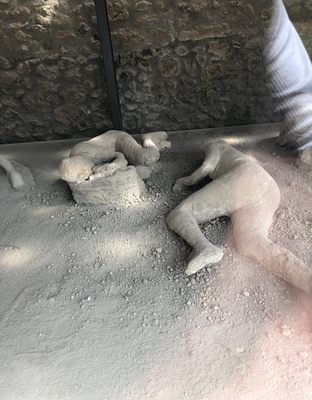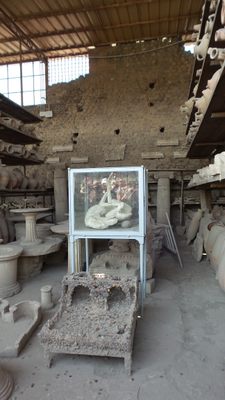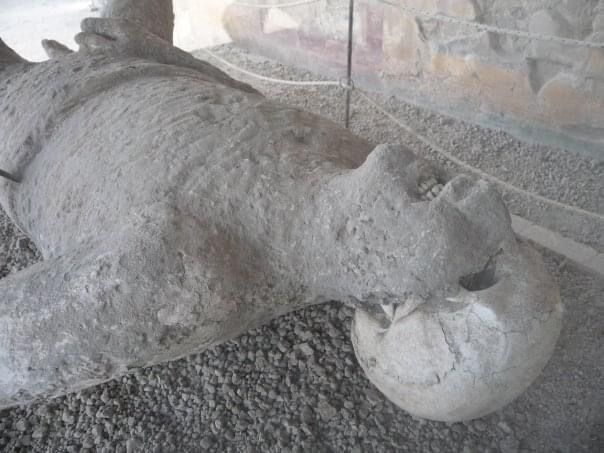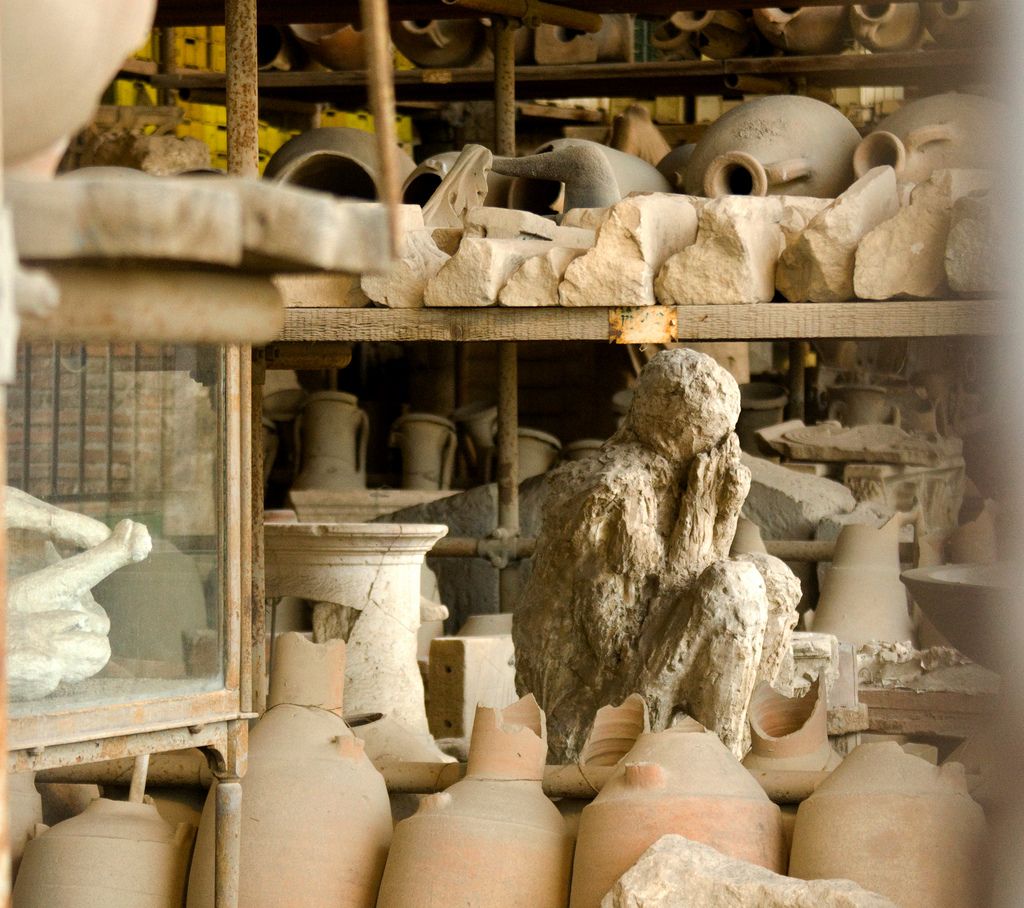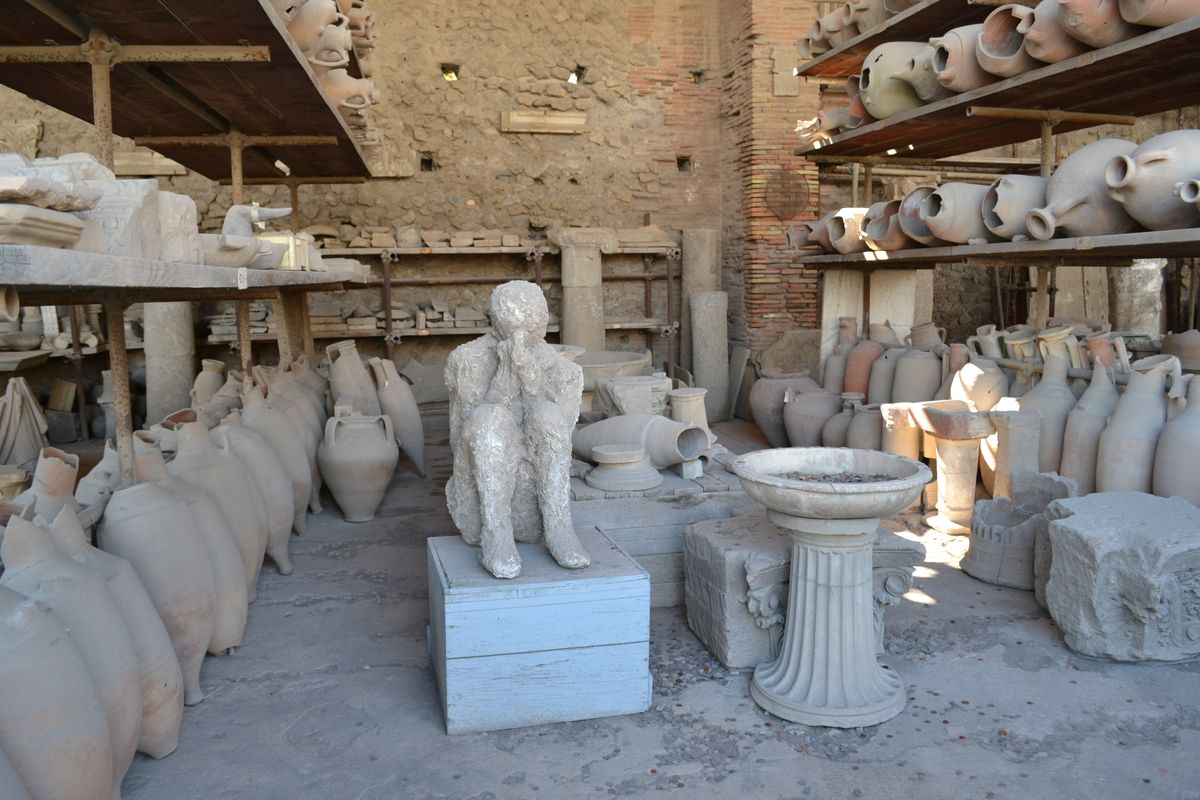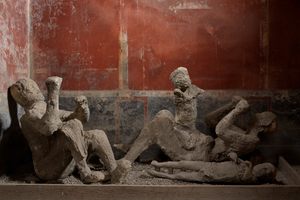About
Those that did not flee the city of Pompeii in August of 79 AD were doomed. Buried for 1,700 years under 30 feet of mud and ash and reduced by the centuries to skeletons, they remained entombed until excavations in the early 1800s.
As excavators continued to uncover human remains, they noticed that the skeletons were surrounded by voids in the compacted ash. By carefully pouring plaster of Paris into the spaces, the final poses, clothing, and faces of the last residents of Pompeii came to life.
The beginning of the end was August 24, 79 AD, the day after the Roman holiday of Volcanalia, dedicated to the god of fire. At noon Mount Vesuvius roared to life, spewing ash hundreds of feet into the air for 18 hours straight. The choking ash rained down on the cities in the surrounding countryside, filling courtyards, blocking doors, and collapsing roofs. In the only known eye witness account to the eruption, Pliny the Younger reported on his uncle's ill-fated foray into the thick of the ash from Misenum, on the north end of the bay:
"...the buildings were now shaking with violent shocks, and seemed to be swaying to and fro as if they were torn from their foundations. Outside, on the other hand, there was the danger of failing pumice stones, even though these were light and porous; however, after comparing the risks they chose the latter. In my uncle's case one reason outweighed the other, but for the others it was a choice of fears. As a protection against falling objects they put pillows on their heads tied down with cloths. "
And then:
"You could hear the shrieks of women, the wailing of infants, and the shouting of men; some were calling their parents, others their children or their wives, trying to recognize them by their voices. People bewailed their own fate or that of their relatives, and there were some who prayed for death in their terror of dying. Many besought the aid of the gods, but still more imagined there were no gods left, and that the universe was plunged into eternal darkness for evermore."
The next morning, the cone of the volcano collapsed, triggering a hundred mile an hour avalanche of mud and ash that flooded Pompeii, just a little over five miles away, and destroyed everything in its path. Pompeii and its smaller neighboring village of Herculaneum disappeared, and were only discovered by accident during the construction of King Charles III of Bourbon's palace in 1738. Miraculously, the two cities were nearly perfectly preserved under calcified layers of ash.
About 3/4 of Pompeii's 165 acres have been excavated, and some 1,150 bodies have been discovered out of an estimated 2,000 thought to have died in the disaster. This means that the vast majority of the city of 20,000 fled at the first signs of the volcanic activity. The plaster casts of the men, women, children, and animals of Pompeii were primarily made in the mid 1800s.
The Antiquarium, near the Forum, once held most of the plaster casts. It was damaged during Allied bombing in 1943, and has been closed since 1978 for restoration.
The Garden of the Fugitives holds the largest number of victims found in one place, where thirteen people sought refuge in a fruit orchard. Nine sets of remains were found at the House of Mysteries, where the roof collapsed trapping them inside. One plaster cast can be seen inside the Caupona Pherusa tavern.
The Stabian Thermal baths and the Macellum (fish market) both house two plaster casts, and the Horrea (granary) and Olitorium (market) holds several more, including a pig, and what may be the most famous cast of all, a small dog in a collar writhing on its back.
Though Pompeii is still being excavated, new casts are not being made because the plaster damages the fragile remains of of the corpses.
In 2010 an exhibition including several of the Pompeii plaster casts opened at the Antiquarium de Boscoreale, near Pompeii. Many of the artifacts from Pompeii are now located at the National Museum in Naples (Museo Archeologico Nazionale di Napoli), including the famous "Secret Cabinet" of erotic art.
One million people now live in Naples, in the shadow of Vesuvius. According to National Geographic Magazine in 2006, "[Volcanologists] Sheridan and Mastrolorenzo have calculated that there is a greater than 50 percent chance of a major eruption each year now, the odds rising incrementally as the time since the last big plinian event grows longer year by year."
Related Tags
Flavors of Italy: Roman Carbonara, Florentine Steak & Venetian Cocktails
Savor local cuisine across Rome, Florence & Venice.
Book NowCommunity Contributors
Added By
Published
August 19, 2006





